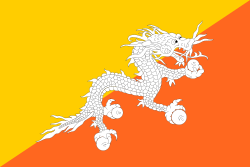

The following outline is provided as an overview of and topical guide to Bhutan:
Contents
- General reference
- Geography of Bhutan
- Environment of Bhutan
- Regions of Bhutan
- Demography of Bhutan
- Government and politics of Bhutan
- Branches of government
- Foreign relations of Bhutan
- Law and order in Bhutan
- Military of Bhutan
- Local government in Bhutan
- History of Bhutan
- Historical events
- Historical families and figures
- Historical government
- Culture of Bhutan
- Art in Bhutan
- Languages in Bhutan
- Sports in Bhutan
- Economy and infrastructure of Bhutan
- Education in Bhutan
- Health in Bhutan
- See also
- Sources
- References
- External links
Bhutan – landlocked sovereign country located in South Asia. [1] Bhutan is located amidst the eastern end of the Himalaya Mountains and is bordered to the south, east and west by India and to the north by China. Bhutan is separated from Nepal by the Indian state of Sikkim. The Bhutanese call their country Druk Yul (land of the thunder dragon). [2]
Foreign influences and tourism in Bhutan are regulated by the government to preserve the nation's traditional culture, identity and the environment. in 2006 Business Week rated Bhutan the happiest country in Asia and the eighth happiest country in the world. [3] The landscape ranges from subtropical plains in the south to the Himalayan heights in the north, with some peaks exceeding 7,000 metres (23,000 ft). The state religion is Vajrayana Buddhism, and the population is predominantly Buddhist, with Hinduism being the second-largest religion. The capital and largest city is Thimphu. After centuries of direct monarchic rule, Bhutan held its first democratic elections in March 2008. Bhutan is a member of the South Asian Association for Regional Cooperation (SAARC).





